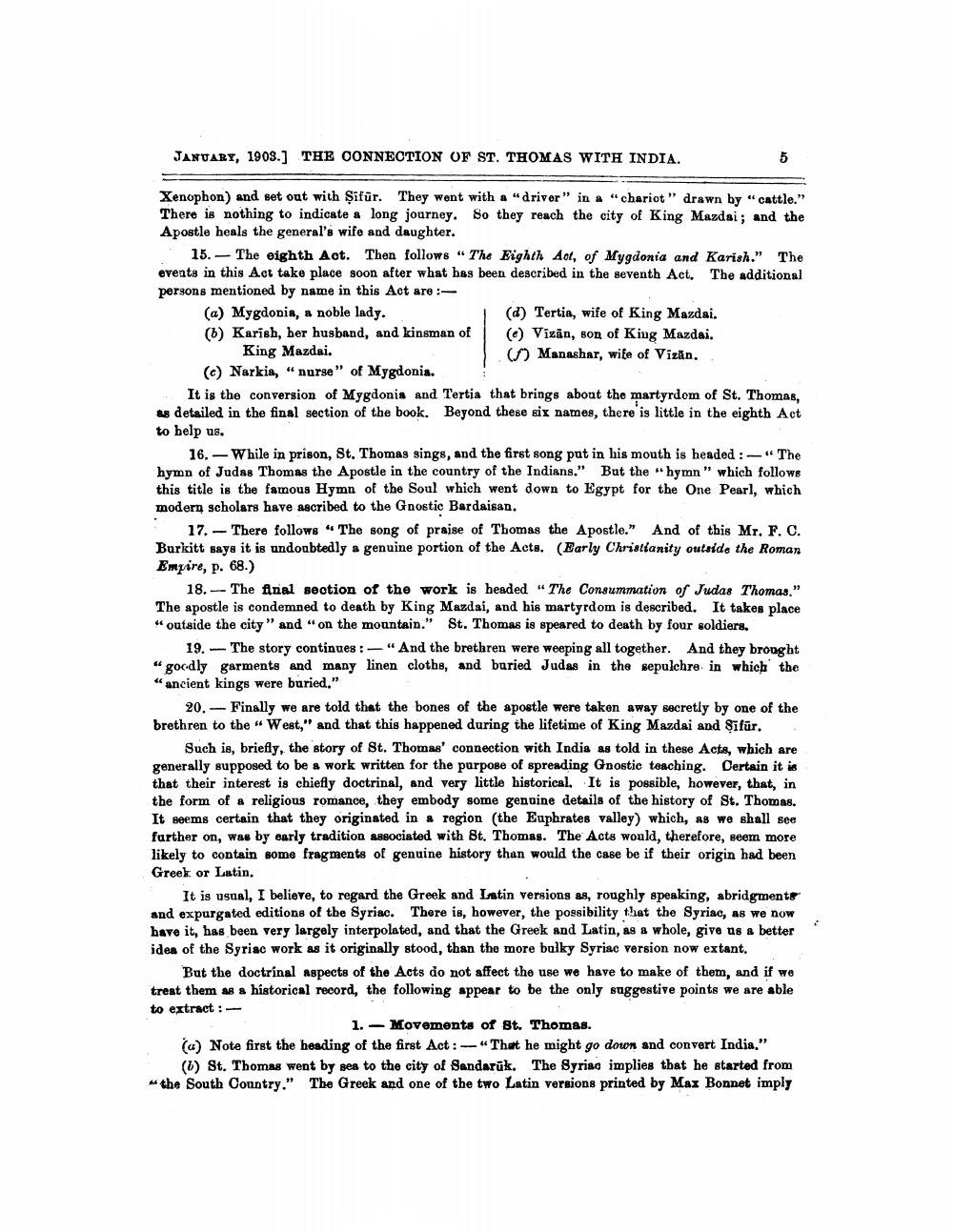________________
JANUARY, 1903.) THE OONNECTION OF ST. THOMAS WITH INDIA.
Xenophon) and set out with Şifür. They went with a "driver" in a “chariot" drawn by "cattle." There is nothing to indicate a long journey. So they reach the city of King Mazdai; and the Apostle heals the general's wife and daughter.
15.- The eighth Act. Then follows "The Eighth Aot, of Mygdonia and Karish." The events in this Act take place soon after what has been described in the seventh Act. The additional persons mentioned by name in this Act are:(a) Mygdonis, & noble lady.
(d) Tertia, wife of King Mazdai. (6) Karish, her husband, and kinsman of (6) Vizān, son of King Mazdai. King Mazdai.
Manashar, wife of Vizan, (c) Narkia, "nurse" of Mygdonia.
It is the conversion of Mygdonia and Tertia that brings about the martyrdom of St. Thomas, as detailed in the final section of the book. Beyond these six names, there is little in the eighth Act to belp us.
16.-While in prison, St. Thomas sings, and the first song put in his mouth is headed : -" The hymn of Judas Thomas the Apostle in the country of the Indians." But the "hymn" which follows this title is the famous Hymn of the Soul which went down to Egypt for the One Pearl, which modern scholars have ascribed to the Gnostic Bardaisan.
17. There follows "The song of praise of Thomas the Apostle." And of this Mr. F. C. Burkitt says it is undoubtedly a genuine portion of the Acts. (Early Christianity outside the Roman Empire, p. 68.)
18. The final section of the work is headed " The Consummation of Judas Thomas." The apostle is condemned to death by King Mazdai, and his martyrdom is described. It takes place “outside the city" and "on the mountain." St. Thomas is speared to death by four soldiers.
19. - The story continues : -"And the brethren were weeping all together. And they brought “goodly garments and many linen cloths, and buried Judas in the sepulchre in which the "ancient kings were buried."
20. Finally we are told that the bones of the apostle were taken away secretly by one of the brethren to the West," and that this happened during the lifetime of King Mazdai and Sifür.
Such is, briefly, the story of St. Thomas' connection with India as told in these Acts, which are generally supposed to be a work written for the purpose of spreading Gnostic teaching. Certain it is that their interest is chiefly doctrinal, and very little historical. It is possible, however, that, in the form of a religious romance, they embody some genuine details of the history of St. Thomas. It seems certain that they originated in a region (the Euphrates valley) which, as we shall see further on, was by early tradition associated with St. Thomas. The Acts would, therefore, seem more likely to contain some fragments of genuine history than would the case be if their origin had been Greek or Latin.
It is usual, I believe, to regard the Greek and Latin versions as, roughly speaking, abridgments and expurgated editions of the Syriac. There is, however, the possibility that the Syriac, as we now have it, has been very largely interpolated, and that the Greek and Latin, as a whole, give us a better idea of the Syriac work as it originally stood, than the more bulky Syriac version now extant.
But the doctrinal aspects of the Acts do not affect the use we have to make of them, and if we treat them as a historical record, the following appear to be the only suggestive points we are able to extract:
1. - Movements of St. Thomas. (a) Note first the heading of the first Act :- "That he might go down and convert India."
(6) St. Thomas went by ses to the city of Sandarūk. The Syriac implies that he started from " the South Country." The Greek and one of the two Latin versions printed by Max Bonnet imply




